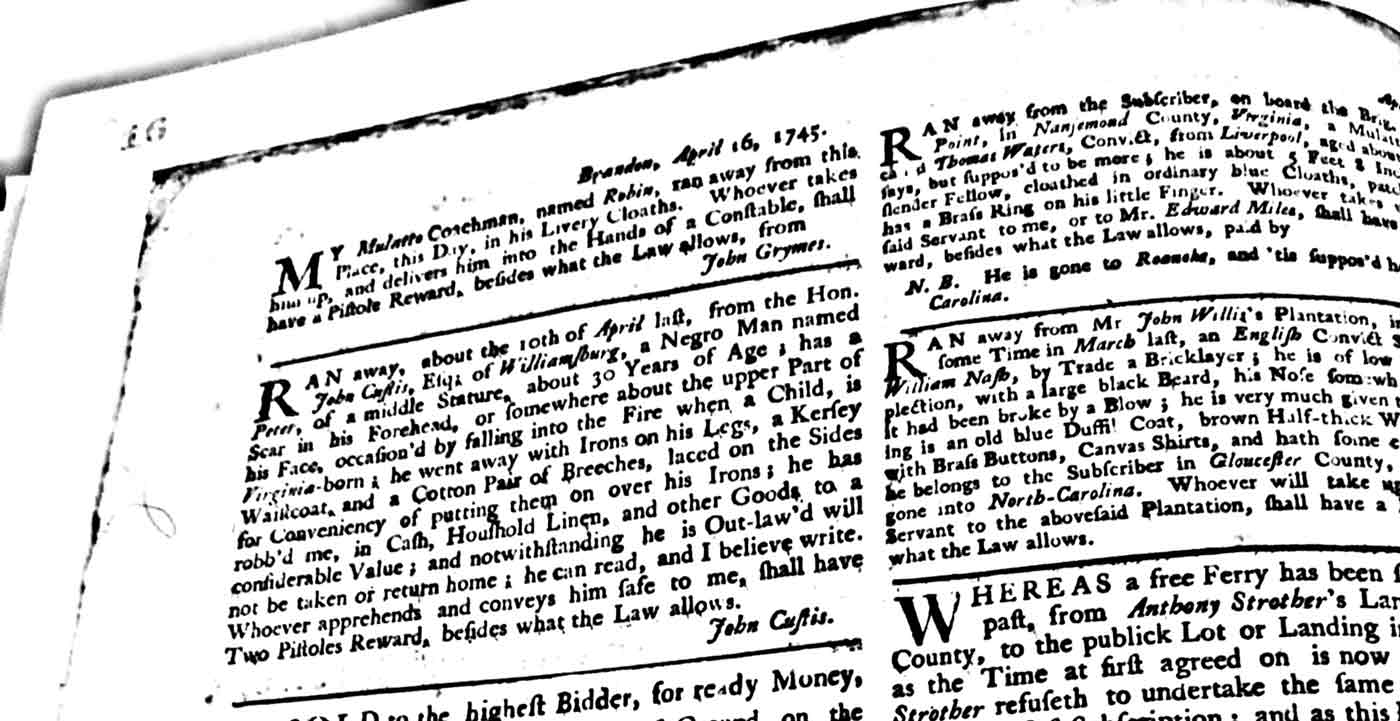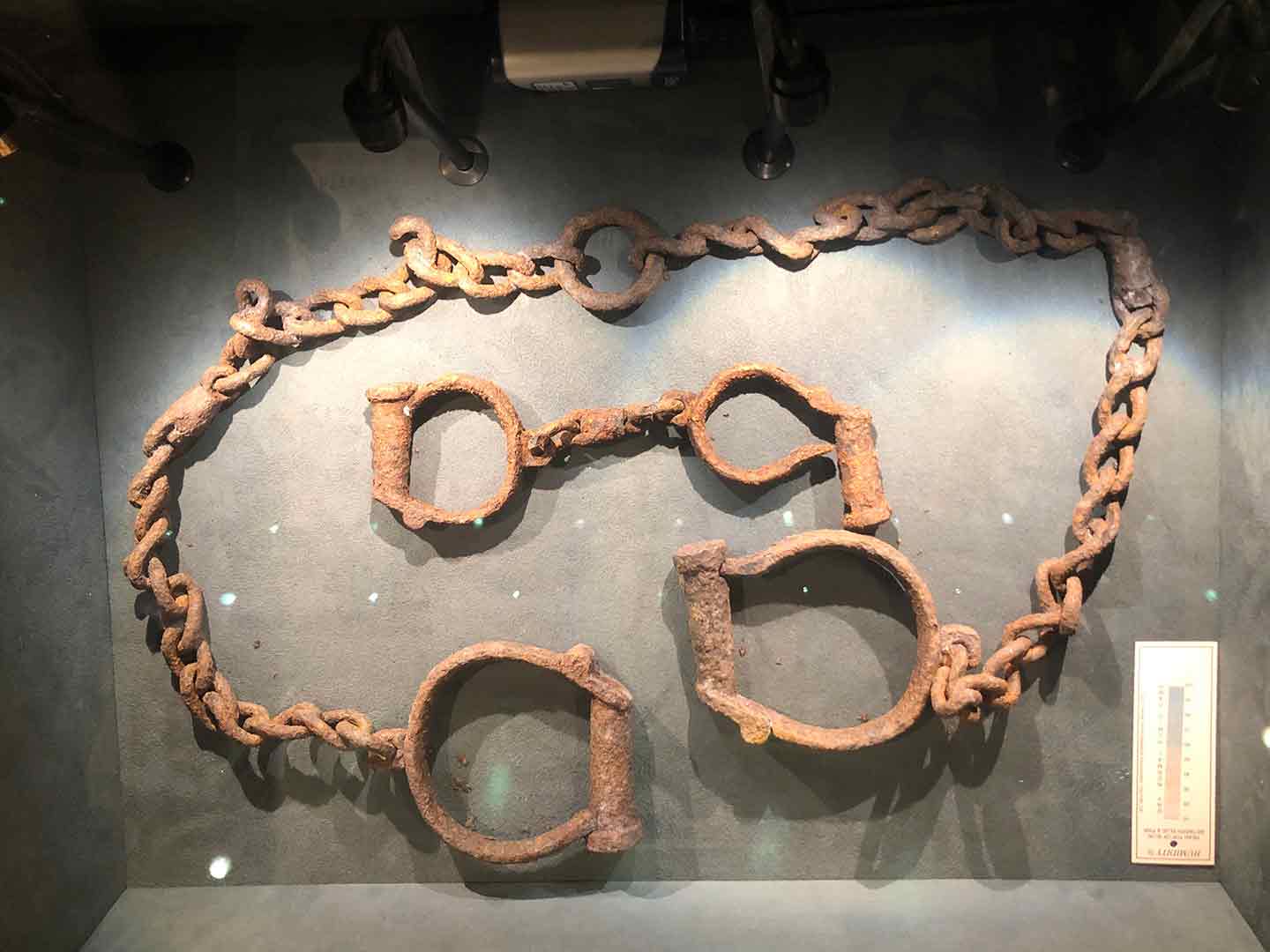My name is Cheyenne Johnson and I’m a member of the archaeology crew excavating at Custis Square. As part of my work, I am researching the enslaved community associated with the Custis family, and more specifically, John Custis’s Williamsburg properties. As we come closer to understanding some of their stories, we hope to share biographies on the Custis Square webpage, so stay tuned!
John Custis IV (b.1678- d.1749) and his family owned hundreds of slaves, and for most, we have little information aside from a name. But for a few, we know more, and we can begin to piece together their story — their identity beyond a name or occupation. The city of Williamsburg’s population during the colonial period was about 50 percent Black. Meaning the history of Colonial Williamsburg itself, is also 50 percent Black. Their history is woven throughout Williamsburg’s built environment, on each street, each building, and each corner. There were no separate buildings or spaces to denote whose space was strictly whose. This is something we can investigate archaeologically and compare Custis Square to the rest of Williamsburg.
As the archaeology field crew at Custis Square works to understand the built world of the Williamsburg estate along with the tangible artifacts of those who lived there, we are also digging through another wealth of information in the archives. Documentation in the form of primary and secondary resources is an essential aspect of authentically interpreting the information we uncover archaeologically. Primary sources from the voices of enslaved Africans during the 18th century are relatively scarce, as it was generally an uncommon practice for enslavers to encourage their enslaved to read and write; however, it was not illegal for those in the enslaved community to read or write. Because of this, a lot of our information will come from John Custis IV’s letters, Virginia Gazette runaway ads, diary entries, and papers associated with George Washington (who through his marriage to Martha Dandridge Custis came into ownership of many of John Custis’s enslaved).
One of the few individuals we do know a bit more about is a man named Peter. On April 10, 1745, Peter effectively self-emancipated himself through running away. A runaway ad was placed in the Virginia Gazette by John Custis on April 16, 1745. It stated
“… , a Negro Man named Peter, of middle Stature, about 30 years of Age; has a Scar in his Forehead, or somewhere about the upper part of his Face, occasion’d by falling into the Fire when a Child, is Virginia-born; he went away in irons on his Legs, a Kersey Waistcoat, and a cotton pair of breaches, laced on the side for Conveniency of putting them on over his Irons; he has robb’d me, in cash, Household linen, and other Goods to a considerable Value; and not withstanding he is Out-law’d will not be taken or return home; he can read, and I believe write. Whoever apprehends and conveys him safe to me, shall have Two Pistoles Reward, besides what the law allows.”

Since this ad was placed in Williamsburg it can be inferred that Peter fled from one of Custis’s Williamsburg properties—maybe even Custis Square. This ad tells us a great deal about Peter, and we can actually visualize what he looked like. The scar on his forehead gives us an idea into his childhood; maybe he was playing and fell, or perhaps he just tripped. Being so close to a fire, perhaps, means that his mom was a cook or a laundress and he spent a significant amount of time near a fire as a little kid. This is just speculation, however, there are many other scenarios in which young Peter could have gotten his scar. The ad mentions his clothes; a Kersery waistcoat, which is made of cheap wool, and a cotton pair of breeches. We find evidence of Custis frequently ordering yards of cotton and “kersy” through letters between him and his merchants in England. Also noted in the description of his clothes, is that Peter has almost certainly run away before. His pants are made specifically to accommodate his leg irons. Whether this was meant to hide his leg irons from public view, or was necessary in allowing Peter to undress while still having his legs chained or both.
The specific design leads us to believe that the leg irons were a long term punishment; moreover, he likely had little to no chance for them to be taken off, not even to bathe or change clothes. Custis continued needing Peter to work, yet did not want to have the leg irons brought attention. Not only did Peter run away, he ran away while STILL in leg irons! What strength, both emotional and physical, it must have taken to accomplish that.
It is also interesting to note that, even though Peter had presumably run away before, John Custis kept him close. He didn’t send him off to one of his numerous other plantations, some as remote as the Eastern Shore, to discourage any further attempts at running away. He kept him in the Williamsburg area. All of these are mere speculations of Peters past, but they’re not baseless in their interpretation. We do not know where he was going or if he was going to see someone. It is unclear if Peter was ever captured, as we have not found any other mentions of him in court documents or otherwise. Hopefully, Peter succeeded, persevering and surviving to achieve his own self-emancipation.

At the end of the runaway ad we learn another critical piece of information about Peter: his apparent ability to read and write. Earlier I mentioned how there are not a lot of primary sources from people of color in the colonies during the 18th century due to owners not encouraging enslaved people to write; however, there are still many accounts of enslaved individuals who through various ways learned how to read and/or write, like Peter. The ad states that Peter can read, and that Custis believes he can write. It is unclear how John Custis felt about the education of slaves, but Peter learned somewhere. Perhaps he learned from one of the other individuals owned by Custis, considering there was likely a sense of community among those enslaved at Custis Square and beyond. Sharing and teaching literacy among themselves is a very real possibility. Another avenue by which Peter may have learned is through working and living close to John Custis. Custis was aware of Peter’s ability to read, meaning he might have used that skill when in the company of Custis. The ability to write might have been self-taught, evolving from his ability to read. It is evident that Peter is a strong-willed and persistent man; teaching himself to write is just as likely as him having been taught by a member of his own enslaved community. When Peter ran away, he knew that there was a high chance a reward would be offered and that people would come searching for him. If Peter was able to read, the possibility that he saw the advertisement, and the bounty offered for his capture is really interesting. Would this have been a warning that people would be looking for him? Would he have altered his appearance based on the ads description? We don’t know, and we most likely won’t know, but it is an interesting idea.
It is important to understand a few of the laws that were in place at this time, which would have greatly affected Peter in his self-liberation. They were harsh and violent laws. In 1680 the Virginia General Assembly passed an act that prohibited “any Negro or other slave” (“other slave” can refer to Indigenous populations who were also forced into slavery) from arming themselves in defense or offence with weapons, required those enslaved who wished to leave their enslavers property to have a written “permission” only for necessary reasons. If they did not have this written “permission” the areas constable “is hereby enjoyned and required” to give 20 lashes and sent back to their enslaver. If those self-liberating and fleeing were caught “lurking in obscure places” and “resisting”, the “lawful authority” had the right to kill them. This act was to be republished every six months in the county courts and churches. The Gloucester County Conspiracy (1663) and more widely known Bacon’s Rebellion (1676-1677) among other lesser known rebellions led to the passage of the 1680 act.
In 1691 another act was passed. The act was passed as a result of the Westmoreland Slave Plot (1687). The Westmoreland Slave Plot was a conspiracy where those who were alleged to be involved would kill the white colonists in Virginia and destroy their property. Even though this plot never occurred, it did, however, increase fear in the white community that there would be more acts of resistance by the enslaved community. The 1691 act stated “… any negroes, mulattoes or other slaves or slaves lying out as aforesaid shall resist, runaway, or refuse to deliver and surrender him or themselves to any person or persons that shall be by lawfull authority employed to apprehend and take such negroes, mulattoes or other slaves that in such cases it shall and may be lawfull for such person and persons to kill and distroy such negroes, mulattoes, and other slave or slaves by gunn or any otherwaise whatsoever.” To kill and destroy. Violent language used as a fear tactic to dissuade further acts of rebellion and self-liberation. It continues to state that if the enslaved was killed, the enslaver would be paid 4,000 pounds of tobacco by the public. The law further sates that if emancipated “…by any person or persons whatsoever, unless such person or persons, their heires, executors or administrators pay for the transportation of such negro or negroes out of the countrey within six moneths after such setting them free, upon penalty of paying of tenn pounds sterling to the Church…”. These were examples of a few of the laws Peter was up against. This is the world Peter lived in. His self-liberation was an act of resistance.
Peter is one individual, among hundreds of those held in bondage that John Custis IV and his family claimed as property, who we will be further researching. Understanding the world of the enslaved community in the world of John Custis IV is an on-going, ever-evolving project and, as always, many questions have yet to be answered. As the project continues we will introduce more of those enslaved by Custis and explore their lives.
Archaeology Field Technician Cheyenne Johnson graduated from the University of Mary Washington with a B.A. in Historic Preservation and Museum Studies minor. She was previously a field technician for Ferry Farm, Poplar Forest, and Dovetail CRG.
